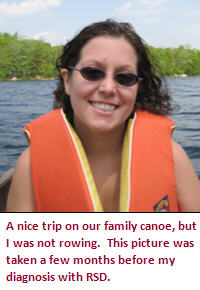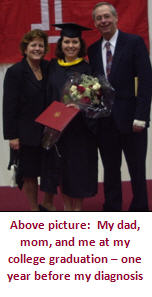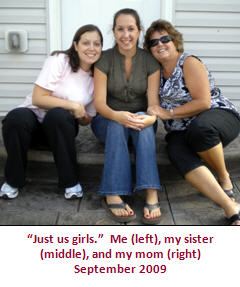At the age of fifteen, I sustained a whiplash injury to my cervical and lumbar spine in an automobile accident, where I was the front seat passenger. I walked away from the accident with no outward signs of injury. Although I underwent months of physical therapy to treat the resulting pain, the pain continued in my neck, shoulders, and lower back. Sometimes I complained to my parents that the pain in my upper body made the weight of my head feel as though it was too heavy for my shoulders. Daily activities, like blow-drying my hair, became a struggle, because my arms felt too heavy. My parents and I brushed it off as “muscle exhaustion” caused by physical therapy.
Over the next two years, I noticed that occasionally my hands turned blue in color, for no apparent reason. With blue hands as my most visible symptom, doctors diagnosed my problem as bilateral thoracic outlet syndrome, or TOS. TOS is a disorder that involves the compression of nerves and/or blood vessels in the brachial plexus area of the body. Recently, I read some statistics about RSD and TOS and  learned that 4% of TOS patients end up with RSD. I continued with additional physical and occupational therapies, but the pain never subsided. At the age of seventeen, I underwent major surgery to remove the left first rib. Doctors felt that the removal of the rib could relieve the pain and tingling I felt throughout my neck, arms, and hands. Instead, my pain level drastically increased with a new numbness and stabbing pain in the back of my left arm. Because my pain level worsened, I did not go forward with the surgical removal of the right first rib. For the first time, I started taking daily medication as a result of my pain. My doctors prescribed Neurontin, Flexeril, and Lidoderm patches to ease my discomfort. I finally started to sleep again.
learned that 4% of TOS patients end up with RSD. I continued with additional physical and occupational therapies, but the pain never subsided. At the age of seventeen, I underwent major surgery to remove the left first rib. Doctors felt that the removal of the rib could relieve the pain and tingling I felt throughout my neck, arms, and hands. Instead, my pain level drastically increased with a new numbness and stabbing pain in the back of my left arm. Because my pain level worsened, I did not go forward with the surgical removal of the right first rib. For the first time, I started taking daily medication as a result of my pain. My doctors prescribed Neurontin, Flexeril, and Lidoderm patches to ease my discomfort. I finally started to sleep again.
Before my injury and subsequent surgery, I was a typical teenager. I loved outdoor activities, such as snow skiing and swimming, hiking and canoeing. I participated in my high school marching band and played the flute. All of these activities greatly aggravated my physical complaints that resulted from the auto accident and surgery, so I stopped the activities. People often ask me whether the initial injury or the surgery caused RSD. The answer is irrelevant. It’s like asking, “Which came first? The chicken or the egg?” The results are the same.
My diagnosis of RSD did not come until five years later, in October 2007. Although I never suspected that I suffered from RSD, I knew about RSD. My close friend’s mother was diagnosed with the “monster” of a disease years before, so I saw firsthand how the disease impacted the lives of my friend’s mom and her family. I felt somewhat relieved to finally get a diagnosis --- one that explained the reasons for my daily pain and the physical changes. I finally knew why things were happening in my body that I couldn’t control, even with accommodations and medications.
I began ketamine infusion treatments at Drexel Neurological Associates in Philadelphia, PA in the summer of 2008. By that time, I graduated from college with a Bachelor’s of Science in Education degree, and I successfully completed my first year as a teacher. I was also well on my way to earning my second Master’s degree. Ever since the second grade, I knew that  teaching would be my vocation in life. I love to teach. It’s so rewarding to help a struggling child, to laugh with the students, and to work with other people who devote themselves to the education of children. It’s all about the kids. Until I became a teacher, I never realized the physical demands of teaching. The job goes along with much standing, walking, stooping, bending, reaching, lifting, and carrying. Of course, all of these activities aggravate RSD. Every day is a challenge.
teaching would be my vocation in life. I love to teach. It’s so rewarding to help a struggling child, to laugh with the students, and to work with other people who devote themselves to the education of children. It’s all about the kids. Until I became a teacher, I never realized the physical demands of teaching. The job goes along with much standing, walking, stooping, bending, reaching, lifting, and carrying. Of course, all of these activities aggravate RSD. Every day is a challenge.
Needless to say, RSD greatly changed my life. My special education background helps me in looking for ways to accommodate myself. Before RSD moved into my legs, I used my legs to assist me in some of the small activities that I would usually do with my arms, such as opening drawers and moving an object across the floor. Now, I try to minimize the stress and strain as much as possible. I am still working on learning how to pace myself. I use a “wheelie” bag to cart my things to and from work. I ask my students to come to my desk to avoid walking too much. I initiate a nightly ritual to try to give myself relief for the next day. I place lidoderm patches on my feet, wear special socks, and pull on knee supports, wrist splints, and a mouth guard – it is quite the “get-up” and routine!
Also, I gave up skiing, swimming, hiking, and canoeing. Playing the flute is no longer an option for me. Many days I cannot hang out with my friends, because of the exhaustion and pain. A forty-five minute drive to visit my sister and brother-in-law is a  very big deal. Most times they come to visit me. Right now, all my strength is taken up with working and trying to complete my second Master’s degree. I expect to graduate in May and then take some time off from my education. I find that it is harder and harder to sit through a class.
very big deal. Most times they come to visit me. Right now, all my strength is taken up with working and trying to complete my second Master’s degree. I expect to graduate in May and then take some time off from my education. I find that it is harder and harder to sit through a class.
When I began ketamine infusion treatments in the summer of 2008, I responded favorably to the treatments. Just as in other RSD scenarios, however, the relief from the treatments is not long lasting. In the meantime, the symptoms of RSD are progressing. Initially, my complaints involved my upper body. In a short time, though, RSD progressed through my body. I feel and notice changes in my thighs, knees, ankles, and feet. My knees and calves swell, and my feet hurt. My twenty-five year old body feels like the body of a ninety year old. On many days, it feels even worse than that.
I want my life back, and I feel hopeful that the ketamine coma will provide favorable results for me. Of course I feel scared, but living with RSD and the worsening of it scares me even more. The most important thing to me is that I be able to continue to work as a teacher. I feel so grateful that people like Dr. Kirkpatrick, Dr. Cantu, and Dr. Schwartzman have dedicated so much of their lives to the research and treatment of this monster of a disease, known as RSD.